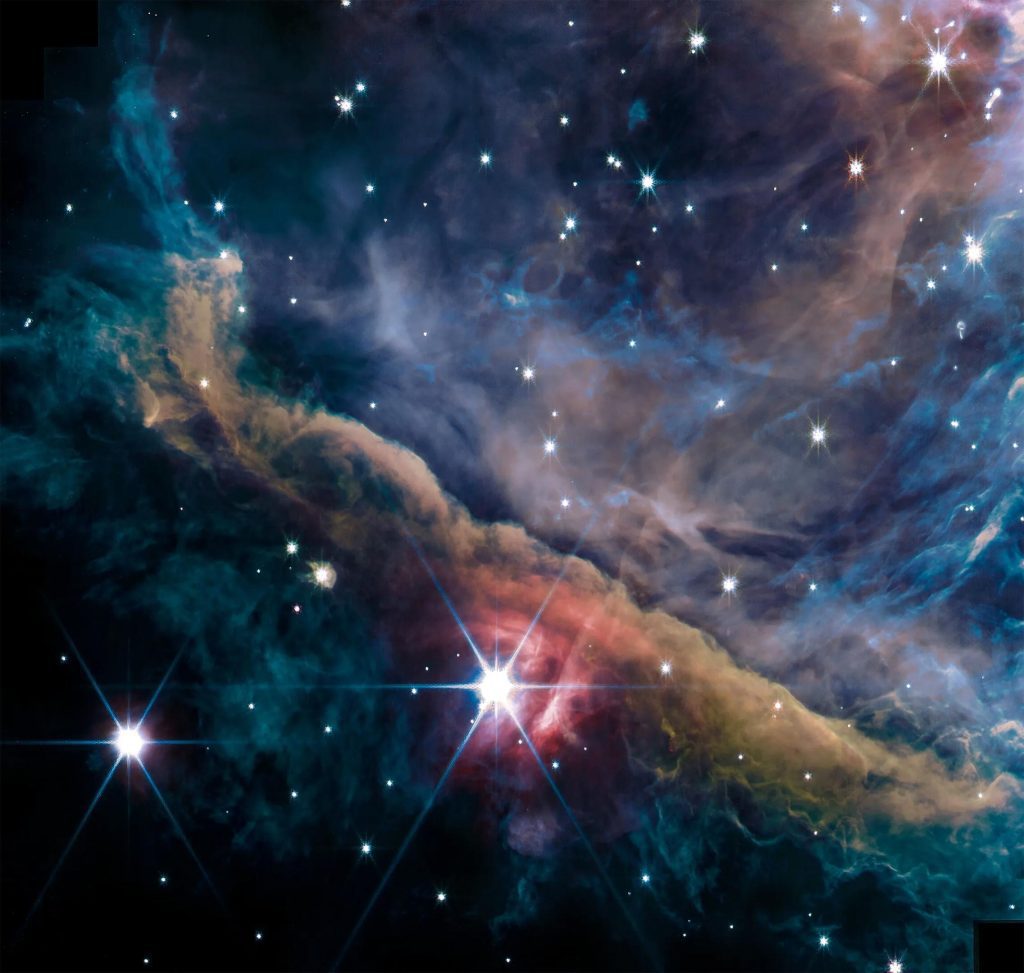
Bagian dalam Nebula Orion seperti yang terlihat oleh instrumen NIRCam dari Teleskop Luar Angkasa James Webb. Ini adalah gambar komposit dari beberapa filter yang mewakili emisi dari gas terionisasi, gas molekuler, hidrokarbon, debu, dan cahaya bintang yang tersebar. Yang paling menonjol adalah Orion Bar, dinding gas dan debu tebal yang membentang dari kiri atas ke kanan bawah di gambar ini, yang berisi bintang terang2 Orionis A. Pemandangan tersebut diterangi oleh sekelompok bintang masif muda yang panas (dikenal sebagai Gugus Trapesium) tepat di kanan atas gambar. Sinar UV yang kuat dan keras dari susunan Trapezium menciptakan lingkungan pengion yang panas di kanan atas, perlahan mengikis batang Orion. Partikel dan debu dapat bertahan lebih lama di lingkungan terlindung yang disediakan oleh pita padat, tetapi ledakan energi bintang mengukir wilayah yang menampilkan kekayaan filamen, bola, dan bintang muda yang menakjubkan dengan cakram dan rongga. Kredit: NASA, ESA, CSA, Pengurangan dan Analisis Data: Tim PDRs4All ERS; S. Fuenmayor .pemrosesan grafis
Gambar Web baru mengungkapkan pemandangan menakjubkan Nebula Orion
“We are blown away by the breathtaking images of the Orion Nebula. We started this project in 2017, so we have been waiting more than five years to get these data,” said Western astrophysicist Els Peeters.
These images have been obtained as part of the Early Release Science program Photodissociation Regions for All (PDRs4All ID 1288) on JWST. Co-led by Peeters, French National Centre for Scientific Research (CNRS) scientist Olivier Berné, and Institut d’Astrophysique Spatiale (IAS) associate professor Emilie Habart, PDRs4All is an international collaboration that involves a team of more than one hundred scientists in 18 countries. Other Western University astrophysicists involved in PDRs4All include Jan Cami, Ameek Sidhu, Ryan Chown, Bethany Schefter, Sofia Pasquini, and Baria Kahn.

Young star with disk inside its cocoon: Planet forming disks of gas and dust around a young star. These disks are being dissipated or “photo-evaporated” due to the strong radiation field of the nearby stars of the Trapezium creating a cocoon of dust and gas around them. Almost 180 of these externally illuminated photoevaporating disks around young stars (aka Proplyds) have been discovered in the Orion nebula, and HST-10 (the one in the picture) is one of the largest known. The orbit of Neptune is shown for comparison.
Filaments: The entire image is rich in filaments of different sizes and shapes. The inset here shows thin, meandering filaments that are especially rich in hydrocarbon molecules and molecular hydrogen.
θ2 Orionis A: The brightest star in this image is θ2 Orionis A, a star that is just bright enough to be seen with the naked eye from a dark location on Earth. Stellar light that is reflecting off dust grains causes the red glow in its immediate surroundings.
Young star inside globule: When dense clouds of gas and dust become gravitationally unstable, they collapse into stellar embryos that gradually grow more massive until they can start nuclear fusion in their core – they start to shine. This young star is still embedded in its natal cloud.
Credit: NASA, ESA, CSA, Data reduction and analysis: PDRs4All ERS Team; graphical processing S. Fuenmayor & O. Berné
“These new observations allow us to better understand how massive stars transform the gas and dust cloud in which they are born,” said Peeters. She is a Western astronomy professor and faculty member at the Institute for Earth and Space Exploration.
“Massive young stars emit large quantities of ultraviolet radiation directly into the native cloud that still surrounds them, and this changes the physical shape of the cloud as well as its chemical makeup. How precisely this works, and how it affects further star and planet formation is not yet well known.”
The newly released images reveal numerous spectacular structures inside the nebula, down to scales comparable to the size of the Solar System.
“We clearly see several dense filaments. These filamentary structures may promote a new generation of stars in the deeper regions of the cloud of dust and gas. Stellar systems already in formation show up as well,” said Berné. “Inside its cocoon, young stars with a disk of dust and gas in which planets form are observed in the nebula. Small cavities dug by new stars being blown by the intense radiation and stellar winds of newborn stars are also clearly visible.”
Proplyds, or ionized protoplanetary disks, consist of a central protostar surrounded by a disk of dust and gas in which planets form. Scattered throughout the images are several protostellar jets, outflows, and nascent stars embedded in dust.
“We have never been able to see the intricate fine details of how interstellar matter is structured in these environments, and to figure out how planetary systems can form in the presence of this harsh radiation. These images reveal the heritage of the interstellar medium in planetary systems,” said Habart.

Orion Nebula: JWST versus Hubble Space Telescope (HST): The inner region of the Orion Nebula as seen by both the Hubble Space Telescope (left) and the James Webb Space Telescope (right). The HST image is dominated by emission from hot ionized gas, highlighting the side of the Orion Bar which is facing the Trapezium Cluster (off the top right of the image). The JWST image also shows the cooler molecular material that is slightly further away from the Trapezium Cluster (compare the location of the Orion Bar relative to the bright star θ2 Orionis A for example). Webb’s sensitive infrared vision can furthermore peer through thick dust layers and see fainter stars. This will allow scientists to study what is happening deep inside the nebula.
Credit: NASA, ESA, CSA, PDRs4All ERS Team; image processing Olivier Berné.
Credit for the HST image: NASA/STScI/Rice Univ./C.O’Dell et al. – Program ID: PRC95-45a. Technical details: The HST image used WFPC2 mosaic. This composite image uses [OIII] (biru), hidrogen terionisasi (hijau), dan [NII] (merah).
Evolusi analog
Nebula Orion telah lama dianggap sebagai lingkungan yang mirip dengan Tempat Lahirnya Tata Surya (ketika terbentuk lebih dari 4,5 miliar tahun yang lalu). Inilah sebabnya mengapa para ilmuwan saat ini tertarik untuk mengamati Nebula Orion. Mereka berharap untuk memahami, dengan analogi, apa yang terjadi selama jutaan tahun pertama evolusi planet kita.
Karena inti pembibitan bintang seperti Nebula Orion dikaburkan oleh sejumlah besar debu bintang, tidak mungkin untuk mempelajari apa yang terjadi di dalamnya dalam cahaya tampak dengan teleskop seperti Teleskop Luar Angkasa Hubble. Webb mendeteksi file cahaya inframerah dari kosmos, memungkinkan para astronom untuk melihat lapisan debu ini dan mendeteksi gerakan yang terjadi di kedalaman nebula.

Bagian dalam Nebula Orion seperti yang terlihat oleh Teleskop Luar Angkasa Spitzer (kiri) dan Teleskop Luar Angkasa James Webb (kanan). Kedua gambar direkam menggunakan filter yang sangat sensitif terhadap emisi dari debu hidrokarbon yang bersinar di seluruh gambar. Perbandingan ini secara menakjubkan menunjukkan betapa akuratnya gambar Webb dibandingkan dengan pendahulunya inframerah, Teleskop Luar Angkasa Spitzer. Ini langsung terlihat dari filamen kompleks, tetapi mata tajam Webb juga memungkinkan kita untuk membedakan bintang dengan lebih baik dari globul dan cakram protoplanet.
Kredit gambar NIRCam: NASA, ESA, CSA, PDRs4All ERS Team; Pemrosesan gambar oleh Olivier Bernet.
Kredit gambar Spitzer: NASA/JPL-Caltech/T. Meggeth (University of Toledo, Ohio)
Detail teknis: Gambar Spitzer menunjukkan cahaya inframerah pada 3,6 mikron yang ditangkap oleh Spitzer Infrared Array Camera (IRAC). Gambar JWST menunjukkan cahaya inframerah pada 3,35 m yang ditangkap oleh JWST NIRCam. Piksel hitam adalah artefak yang disebabkan oleh detektor yang jenuh dengan bintang terang.
“Mengamati Nebula Orion telah menjadi tantangan karena terlalu terang untuk perangkat sensitif Webb yang belum pernah terjadi sebelumnya. Tapi Webb luar biasa, Webb juga dapat mengamati galaksi yang jauh dan redup.”[{” attribute=””>Jupiter and Orion, which are some of the brightest sources in the infrared sky,” said Berné.
At the heart of the Orion Nebula is the ‘trapezium cluster’ (also known as Theta Orionis), which was discovered by Galileo. It contains young massive stars whose intense ultraviolet radiation shapes the cloud of dust and gas. Understanding how this intense radiation impacts their surroundings is a key question in understanding the formation of stellar systems like our own solar system.
“Seeing these first images of the Orion Nebula is just the beginning. The PDRs4All team is working hard to analyze the Orion data and we expect new discoveries about these early phases of the formation of stellar systems,” said Habart. “We are excited to be part of Webb’s journey of discoveries.”
Webb is the most powerful space telescope ever created in human history. It was developed in partnership with NASA, the European Space Agency, and the Canadian Space Agency (CSA), and boasts an iconic 6.5-meter-wide mirror, consisting of a honeycomb-like pattern of 18 hexagonal, gold-coated mirror segments and a five-layer, diamond-shaped sunshield the size of a tennis court. As a partner, CSA receives a guaranteed share of Webb’s observation time, making Canadian scientists some of the first to study data collected by the most advanced space telescope ever constructed.

“Penyelenggara amatir. Penginjil bir Wannabe. Penggemar web umum. Ninja internet bersertifikat. Pembaca yang rajin.”






More Stories
Makhluk yang menjadi fosil mungkin bisa menjelaskan gambar membingungkan di dinding batu
Gambar dramatis dari bulan panen raksasa dan gerhana bulan sebagian
SpaceX meluncurkan satelit Galileo Komisi Eropa dengan roket Falcon 9 dari Cape Canaveral – SpaceflightNow